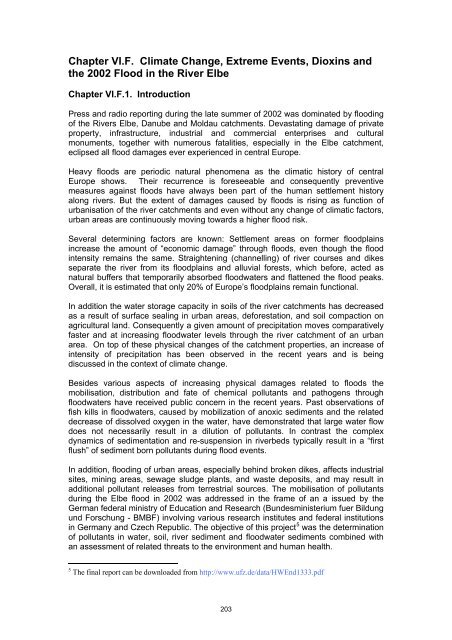Climate Change and the European Water Dimension - Agri ...
Climate Change and the European Water Dimension - Agri ...
Climate Change and the European Water Dimension - Agri ...
Create successful ePaper yourself
Turn your PDF publications into a flip-book with our unique Google optimized e-Paper software.
Chapter VI.F. <strong>Climate</strong> <strong>Change</strong>, Extreme Events, Dioxins <strong>and</strong><br />
<strong>the</strong> 2002 Flood in <strong>the</strong> River Elbe<br />
Chapter VI.F.1. Introduction<br />
Press <strong>and</strong> radio reporting during <strong>the</strong> late summer of 2002 was dominated by flooding<br />
of <strong>the</strong> Rivers Elbe, Danube <strong>and</strong> Moldau catchments. Devastating damage of private<br />
property, infrastructure, industrial <strong>and</strong> commercial enterprises <strong>and</strong> cultural<br />
monuments, toge<strong>the</strong>r with numerous fatalities, especially in <strong>the</strong> Elbe catchment,<br />
eclipsed all flood damages ever experienced in central Europe.<br />
Heavy floods are periodic natural phenomena as <strong>the</strong> climatic history of central<br />
Europe shows. Their recurrence is foreseeable <strong>and</strong> consequently preventive<br />
measures against floods have always been part of <strong>the</strong> human settlement history<br />
along rivers. But <strong>the</strong> extent of damages caused by floods is rising as function of<br />
urbanisation of <strong>the</strong> river catchments <strong>and</strong> even without any change of climatic factors,<br />
urban areas are continuously moving towards a higher flood risk.<br />
Several determining factors are known: Settlement areas on former floodplains<br />
increase <strong>the</strong> amount of “economic damage” through floods, even though <strong>the</strong> flood<br />
intensity remains <strong>the</strong> same. Straightening (channelling) of river courses <strong>and</strong> dikes<br />
separate <strong>the</strong> river from its floodplains <strong>and</strong> alluvial forests, which before, acted as<br />
natural buffers that temporarily absorbed floodwaters <strong>and</strong> flattened <strong>the</strong> flood peaks.<br />
Overall, it is estimated that only 20% of Europe’s floodplains remain functional.<br />
In addition <strong>the</strong> water storage capacity in soils of <strong>the</strong> river catchments has decreased<br />
as a result of surface sealing in urban areas, deforestation, <strong>and</strong> soil compaction on<br />
agricultural l<strong>and</strong>. Consequently a given amount of precipitation moves comparatively<br />
faster <strong>and</strong> at increasing floodwater levels through <strong>the</strong> river catchment of an urban<br />
area. On top of <strong>the</strong>se physical changes of <strong>the</strong> catchment properties, an increase of<br />
intensity of precipitation has been observed in <strong>the</strong> recent years <strong>and</strong> is being<br />
discussed in <strong>the</strong> context of climate change.<br />
Besides various aspects of increasing physical damages related to floods <strong>the</strong><br />
mobilisation, distribution <strong>and</strong> fate of chemical pollutants <strong>and</strong> pathogens through<br />
floodwaters have received public concern in <strong>the</strong> recent years. Past observations of<br />
fish kills in floodwaters, caused by mobilization of anoxic sediments <strong>and</strong> <strong>the</strong> related<br />
decrease of dissolved oxygen in <strong>the</strong> water, have demonstrated that large water flow<br />
does not necessarily result in a dilution of pollutants. In contrast <strong>the</strong> complex<br />
dynamics of sedimentation <strong>and</strong> re-suspension in riverbeds typically result in a “first<br />
flush” of sediment born pollutants during flood events.<br />
In addition, flooding of urban areas, especially behind broken dikes, affects industrial<br />
sites, mining areas, sewage sludge plants, <strong>and</strong> waste deposits, <strong>and</strong> may result in<br />
additional pollutant releases from terrestrial sources. The mobilisation of pollutants<br />
during <strong>the</strong> Elbe flood in 2002 was addressed in <strong>the</strong> frame of an a issued by <strong>the</strong><br />
German federal ministry of Education <strong>and</strong> Research (Bundesministerium fuer Bildung<br />
und Forschung - BMBF) involving various research institutes <strong>and</strong> federal institutions<br />
in Germany <strong>and</strong> Czech Republic. The objective of this project 5 was <strong>the</strong> determination<br />
of pollutants in water, soil, river sediment <strong>and</strong> floodwater sediments combined with<br />
an assessment of related threats to <strong>the</strong> environment <strong>and</strong> human health.<br />
5 The final report can be downloaded from http://www.ufz.de/data/HWEnd1333.pdf<br />
203













